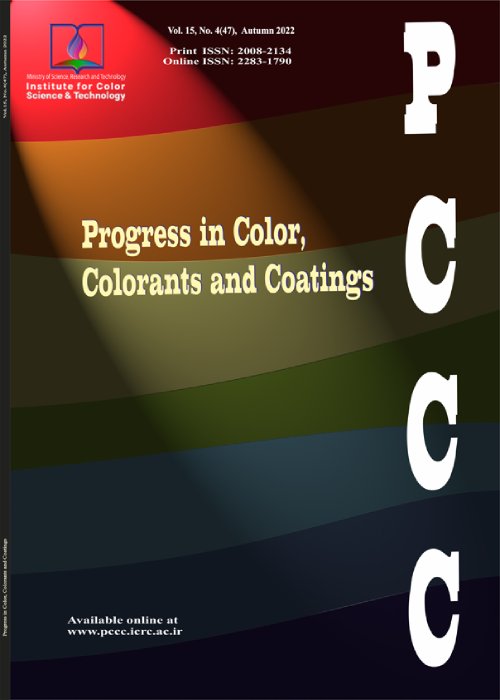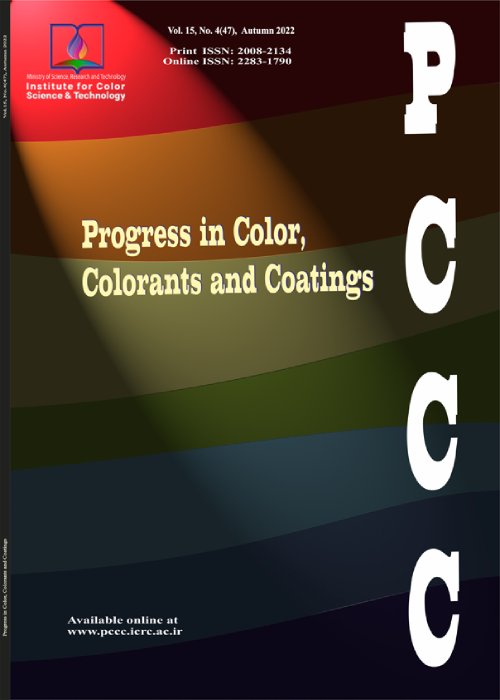فهرست مطالب

Progress in Color, Colorants and Coatings
Volume:16 Issue: 2, Spring 2023
- تاریخ انتشار: 1401/11/09
- تعداد عناوین: 8
-
-
Pages 113-124
The destructive tests are limited for investigate the ancient buildings and non-destructive tests or statistical approaches are preferred instead. In this research, the chemical composition of Soltaniyeh Dome tiles was investigated with a statistical approach. Characterization of colored glazed tiles belonging to historical collection of SD was performed using portable XRF, followed by comparison of samples using PCA/Euclidean distance analysis was made. Decorated motifs which were investigated in this study were blue, green, yellow, white and black colors. According to the classification performed by principal component analysis, three groups of glaze composition, consist of bright colors (Group 1), dark colors (Group 2) and sky blue color (Group 3) was recorded. The results indicated the main differences in the chemical composition of samples while having similarities in the existing colors. The reason was related to the different sources of raw materials which has been provided in periods of time. A similarities were observed between the color composition of pottery glazed tiles and the color composition reported on gypsum surfaces by previous researchers.</em>
Keywords: Soltaniye dome, Portable XRF, Ancient hand-maid tile, Principal component analysis -
Pages 125-138
An antibiotic drug, cefuroxime, is applied on the mild steel surface after the expiry date is over, in various concentrations in 0.5 M sulphuric acid solution, to study the corrosion inhibition by using the weight loss method at various temperatures ranging from 298 to 338 K. Potentiodynamic polarization techniques, i.e., polarization resistance and tafel polarization and Electrochemical Impedance Spectroscopy studies were done at room temperature and the results are in good agreement with the weight loss data. It has a high inhibition activity at lower temperatures. It is found that inhibition efficiency decreases with the increase in time and acid concentration. The activation parameters, Gibbs free energy, enthalpy, and entropy of the reaction were also calculated. It is postulated that the inhibition process is the physical adsorption of the cefuroxime on the metal surface. Langmuir's adsorption isotherm governs the adsorption process. It is also supported by the roughness calculation done by the atomic force microscopic technique. </em>
Keywords: Mild steel, Sulphuric acid, Weight loss, EIS, Acid corrosion -
Pages 139-152
In this study, an acid-modified-activated carbon was prepared from the chestnut oak shell as raw material. Carbonization followed by modifying with hydrochloric acid /nitric acid (HCl/HNO3</sub>) was done. Then the modified adsorbent was used to remove methylene blue from aqueous solutions. Different techniques, including scanning electron microscopy (SEM), Brunauer-Emmett-Teller (BET) analysis, and Fourier transform infrared spectroscopy (FTIR), were used for the characterization of the adsorbent. The effects of some experimental parameters, such as pH, adsorbent dosage, contact time, and initial methylene blue concentration, on the removal efficiency were optimized. The optimized parameters were found to be pH, 7, adsorbent dosage, 0.1 g, contact time, 20 min, and initial dye concentration, 50-400 mg L-1</sup>. Different Adsorption kinetics</em> and equilibrium were</em> well described by the pseudo-second-order (R2</sup>= 0.9996)</em> and the Freundlich model compared to the other investigated models. The maximum adsorption capacity of methylene blue was found to be 406.21 mg g-1</sup> which was superior or comparable to other reported adsorbents. The results indicated that the prepared acid-modified adsorbent is efficient for methylene blue removal in wastewater treatments.</em>
Keywords: Dye removal, Activated carbon, Chestnut shell, Adsorption, Acid modified, Methylene blue -
Pages 153-164
For the first time, corrosion inhibition of carbon steel (ck45) in 0.5 M phosphoric acid was studied in the absence and presence of the Tetracycline drug as a friendly corrosion inhibitor. The corrosion resistance was calculated using electrochemical impedance spectroscopy (EIS) and the determination of the polarization curves. The corrosion tests were carried out with different inhibitor concentrations (200, 300, 600, 800, and 1000 ppm) at room temperature, and the most significant inhibitor efficiency was found to be 81 % at 1000 ppm concentration. According to the potentiodynamic polarization measurement results, Tetracycline is a mixed-type inhibitor. The activation energy, the thermodynamic parameters, and the adsorption isotherm were determined from the electrochemical data. The effect of temperature on the corrosion behavior of ck45 steel in 0.5 M H3</sub>PO4</sub> with drug addition was also investigated. It was discovered that the inhibitory efficiency improves with rising temperature, reaching 95 % at 55 °C. Optical microscopy and scanning electronic microscopy (SEM) were employed to investigate the effect of the Tetracycline drug on the surface morphology of metal. </em>
Keywords: Carbon steel, Tetracycline, Green inhibitor, Phosphoric acid -
Pages 165-179
Membrane systems are considered clean and environmentally acceptable for removing dyes from wastewater. Concern about the aquatic environment, which protects humans, is raising demand for its use. This study used polysulfone polymer (PSU) with nanoparticles (SiO2</sub>) by phase inversion. In this case, ultrafiltration membrane (UF) performance was improved. SiO2</sub> nanoparticles (0, 0.025, 0.050, and 0.075 wt. %) were examined, and the polymer concentration was kept constant at 17 wt. %. FTIR, SEM, and AFM tests were used to characterize the composition and structure of the membrane. With varied SiO2</sub> nanoparticle concentrations, the membrane shape changed. Different operating factors such as pressure and dye concentration effect on the permeability flux and removal percentage</em> </em>of Congo Red and Malachite Green dyes were studied. The dye concentration was 100 ppm at 2 to</em> </em>7 bar. The composite membrane permeability improved because SiO2</sub> nanoparticles increased membrane porosity. The results of casting solution composition, membrane mechanical properties, microstructures, water flux, and dye removal were evaluated. Therefore, the ideal SiO2</sub> nanoparticles concentration in the membrane ultrafiltration is 0.025 wt. %. This membrane has a high removal efficiency of 99.5 % at 2</em> </em>bar, which is the optimum operating pressure, and 98.75 % at 7 bar. </strong></em>
Keywords: Composite UF membrane, Polysulfone polymer, Dye removal, SiO2 nanoparticles, Water flux -
Pages 181-195
This paper aimed to investigate the effect of the minimum film formation temperature (MFFT) of acrylic-styrene latexes (ASL) on the durability, physical, and mechanical characteristics of latex-modified concretes (LMCs). LMCs were designed and manufactured incorporating three ASLs with different MFFTs, namely 0, 8, and 25 °C (Water/Cement mass ratio=0.445 and latex/water mass ratio=0.05). Water absorption (WA), rapid chloride ion migration, carbonation, compressive-splitting tensile strength, and scanning electron microscopy (SEM) were employed to study LMCs properties. The performance of LMCs was found to be dependent on the MFFT of the latexes strongly. The results revealed that LMCs containing ASL with lower MFFT compared to ambient temperature (MFFT<25 °C) had a lower slump, compressive and tensile strength, and higher WA, chloride ion, and CO2 penetration due to the higher film formation rate of latexes on the non-hydrated cement particles and the decreased final hydration degree. Furthermore, it was indicated that chloride penetration, water adsorption, and tensile strength of LMCs containing latexes with high MFFT (MFFT>25 °C) decreased by 14 %, 10 and 20 % compared to the conventional concrete, respectively. Such a chloride penetration reduction is a great achievement. Accordingly, carboxylated alkaline ASLs with high MFFT can be a promising candidate for preparing the LMCs, which can be applied in reinforced concrete in corrosive conditions.
Keywords: Minimum film formation temperature Durability Acrylic, styrene latex Non, steady, state migration coefficient Rapid chloride migration test Concrete -
Pages 197-205
Today, it is important to pay attention to the reduction of toxic effluents and pollution caused by industrial effluents. The textile industry and dyeing procedure is one of the most important industries in the world, and its effluent causes environmental pollution. Reducing the use of chemical compounds in the dyeing process can reduce these adverse effects. In this article, the aim is to investigate the use of the natural colorant of Madder in the presence of a mixture of two natural tannins-rich mordant (Myrobalan and Walnut husk). For the application of mordant, the pre-mordanting method is used and their performance is compared with Alum. A mixture of two natural mordant with different percentages, the total of which will be 10 %, was used. The changes in the application of the mordant and the natural dye of the yarns are evaluated using the FTIR test. The removal of the peak related to C-N bonding indicates the proper interaction between the mordant, the dye and the yarns. The results illustrated that the use of mordant and increasing the dye concentration increases the color strength. The results showed that the best percentage of mordant mixing is WH:YM=7.5 %:2.5 %. ISO standards were used to check the fastness properties of dyed yarns and moderate to good results were obtained.
Keywords: Bio, mordant Green dyeing Walnut husk Wool fibers Fastness properties -
Pages 207-219
Novel routes are continuously innovated in the textile industry to obtain high-performance products, and the development of functional textiles using functional dyes is an attractive alternative to existing methods. In this context, the current study reports the synthesis of a new acid dye to develop mosquito-repellent and UV-protective nylon. The acid dye was synthesized by reacting a diazotized derivative of ethyl anthranilate (ethyl 2-aminobenzoate) with H-acid (4-Amino-5-hydroxy-2,7-naphthalenedisulfonic acid). The synthesized dye was thoroughly characterized through Fourier-transform infrared spectroscopy (FTIR), proton nuclear magnetic resonance (1H NMR),13C NMR (Carbon-13 NMR) spectroscopy, elemental analysis (CHN analyzer), and UV-Vis spectroscopy. The dye was used to dye nylon, and dyeing characteristics (exhaustion and fixation) were examined. The functional effects and coloring properties of dyed fabrics were further investigated. The dyed fabrics were also characterized by X-ray diffraction (XRD) and thermogravimetric analysis (TGA). The dyed fabrics were imparted with 100 % mosquito repellency and excellent UV protection.
Keywords: Acid dye, Nylon, Mosquito repellent, UV protection


